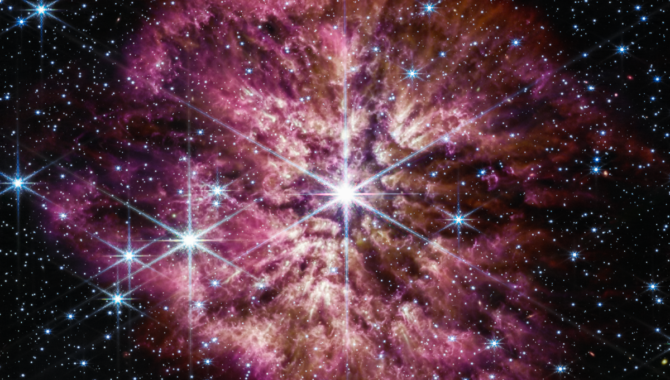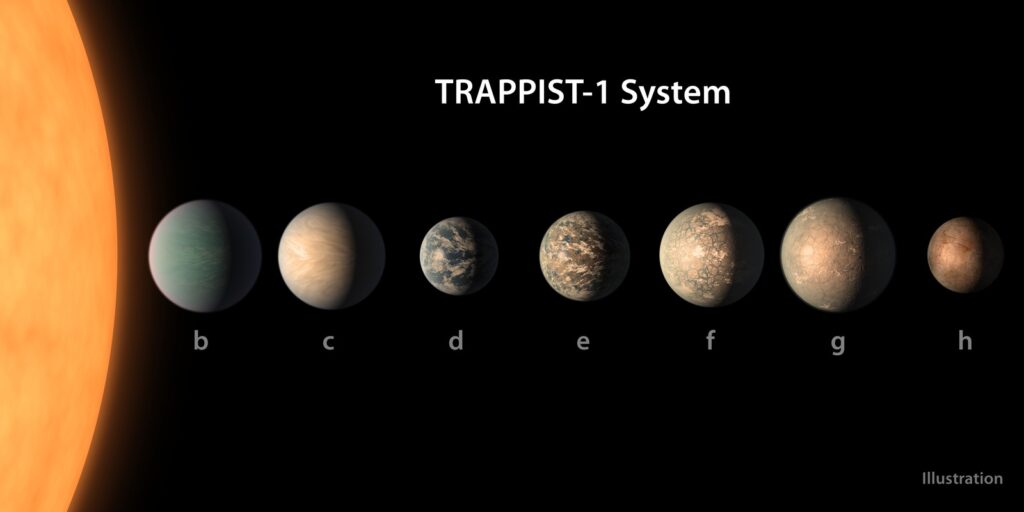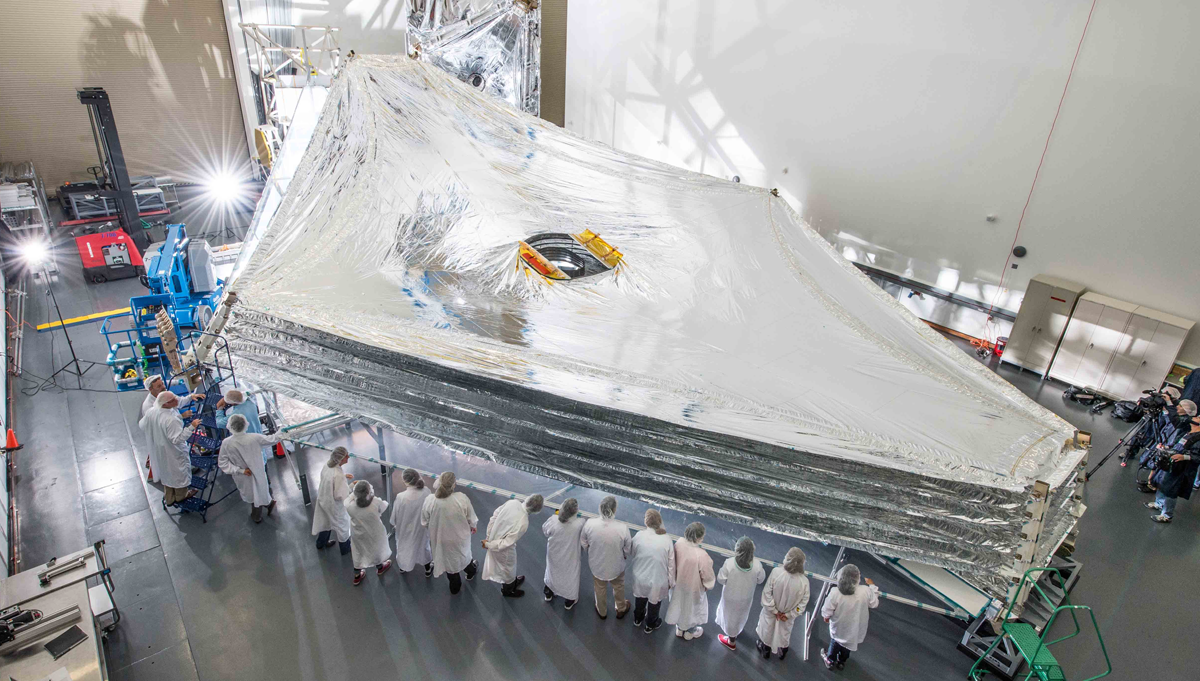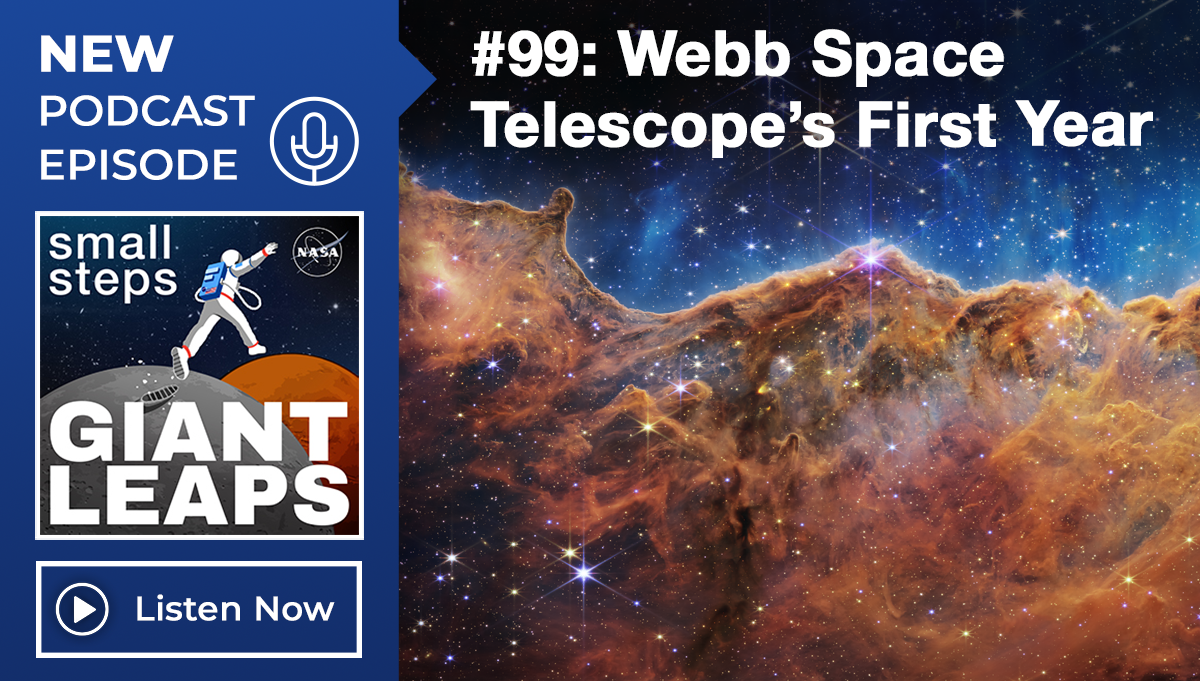
The rare sight of a Wolf-Rayet star captured by NASA’s James Webb Space Telescope in unprecedented detail. Massive stars race through their lifecycles, and only some of them go through a brief Wolf-Rayet phase before going supernova.
Photo Credit: NASA
Space telescope reveals key details of early galaxies, exoplanets.
The James Webb Space Telescope arrived in space on December 25, 2021, a towering achievement in aerospace engineering folded within the fairing of an Ariane 5 rocket. Over the next 29 days, the telescope successfully performed a series of the most intricate deployments ever attempted in space and arrived at its destination—the second Lagrange point, about 930,000 miles from Earth.
The impressive engineering was driven by ambitious science goals, including examining our own solar system in unprecedented detail, observing exoplanets to better discern their characteristics, and looking 13.5 billion years into the past for information from the early Universe when stars as much as 300 times larger than our own Sun formed and ended as supernovas in just a few million years.
From the first images, JWST performed beyond even the most optimistic expectations and is taking its place in the long history of new flagship telescopes that have yielded important discoveries. Scientists around the world have eagerly submitted proposals to secure time with JWST, and the early science has yielded fascinating results.

This artist’s concept shows what the TRAPPIST-1 planetary system may look like, based on available data about the planets’ diameters, masses and distances from the host star, as of February 2018.
Illustration Credit: NASA/JPL-Caltech.
The TRAPPIST-1 planetary system comprises seven exoplanets, all in what is known as the “habitable zone” around a red dwarf star 40 light-years from Earth. The system was discovered in 2017 and quickly became the focus of scientific inquiry. Astronomers are intrigued because the planets are all rocky and contain minerals common to Earth, although in different ratios. A closer study in 2018 revealed that the planets could potentially contain significant amounts of water—atmospheric vapor in the planets closest to the star and ice in the planets furthest away.
A team of astronomers recently studied the second closest planet to the star, TRAPPIST-1 c, using JWST to calculate the amount of heat energy the planet emits. Using a technique called secondary eclipse photometry, the team determined the brightness of the planet by first determining the total brightness before the planet passed behind the star and then subtracting the brightness of the star.

This artist’s concept shows what the hot rocky exoplanet TRAPPIST-1 c could look like. Illustrated in the background is TRAPPIST-1 b, the innermost planet in the TRAPPIST-1 system, and the ultracool red dwarf (M dwarf) star, TRAPPIST-1.
Illustration Credits: NASA, ESA, CSA, Joseph Olmsted (STScI)
The research indicates that although TRAPPIST-1 c is about the same size and mass as Venus, it is much cooler, with dayside temperatures of about 225 degrees Fahrenheit, compared to the more than 850 degrees Fahrenheit of Venus.
“TRAPPIST-1 c is interesting because it’s basically a Venus twin: It’s about the same size as Venus and receives a similar amount of radiation from its host star as Venus gets from the Sun,” explained Laura Kreidberg, of the Max Planck Institute for Astronomy in Germany, in a press release. Kreidberg is a co-author of a paper reporting the team’s findings. “We thought it could have a thick carbon dioxide atmosphere like Venus.”
The research indicates that TRAPPIST-1 c likely has a thin atmosphere or none at all. This could indicate the planet formed with little water. About 75 percent of stars in our galaxy are red dwarfs, known to cast intense solar flares early in their development, powerful enough to alter the composition of a planet’s atmosphere or perhaps even strip it away.
A different team observed TRAPPIST-1 b using secondary eclipse photometry. That research indicates the planet closest to TRAPPIST-1 has a dayside temperature of 450 degrees Fahrenheit.
“This planet is tidally locked, with one side facing the star at all times and the other in permanent darkness,” said Pierre-Olivier Lagage of the French Alternative Energies and Atomic Energy Commission (CEA), in a press release. He is a co-author of a research paper on the results. “If it has an atmosphere to circulate and redistribute the heat, the dayside will be cooler than if there is no atmosphere.”
When the team compared the findings to computer models, they were consistent with expectations for a planet with no atmosphere. “The results are almost perfectly consistent with a blackbody made of bare rock and no atmosphere to circulate the heat. We also didn’t see any signs of light being absorbed by carbon dioxide, which would be apparent in these measurements,” said Elsa Ducrot from CEA, in the same press release.

NASA’s James Webb Space Telescope shows a water vapor plume jetting from the southern pole of Saturn’s moon Enceladus, extending out 20 times the size of the moon itself. The inset, an image from the Cassini orbiter, emphasizes how small Enceladus appears in the Webb image compared to the water plume.
Photo Credits: NASA, ESA, CSA, STScI, and G. Villanueva (NASA’s Goddard Space Flight Center). Image Processing: A. Pagan (STScI).
Closer to Earth, a research team studied Saturn’s icy moon, Enceladus. In 2006, NASA’s Cassini spacecraft returned images of icy jets of water vapor erupting from pockets of liquid water near the moon’s ice surface. Later, researchers used models to show the jets could be driven by hydrothermal activity at the moon’s rocky core, sending warm water upward, where it thins the surface ice and is expelled through fractures.
The team using JWST found evidence that Enceladus, at just 313 miles across, ejected water vapor at a staggering rate—79 gallons a second—sending the plume 6,000 miles out, in the area of Saturn’s E Ring.
“When I was looking at the data, at first, I was thinking I had to be wrong. It was just so shocking to detect a water plume more than 20 times the size of the moon,” said lead author Geronimo Villanueva of NASA’s Goddard Space Flight Center, in a press release. “The water plume extends far beyond its release region at the southern pole.”
“The orbit of Enceladus around Saturn is relatively quick, just 33 hours. As it whips around Saturn, the moon and its jets are basically spitting off water, leaving a halo, almost like a donut, in its wake,” said Villanueva. “In the Webb observations, not only was the plume huge, but there was just water absolutely everywhere.”
Further back in time, researchers have used JWST to pinpoint the role early galaxies played in ionizing the opaque hydrogen gas of the early universe into transparent bubbles that eventually joined until the universe was clear, reveal the violent collision of two spiral galaxies shining with more infrared light than a trillion suns, and capture the prelude to a supernova.
For more, listen to Michael Menzel, the NASA Mission Systems Engineer for the James Webb Space Telescope, discuss the first year in space on this episode of Small Steps, Giant Leaps.









